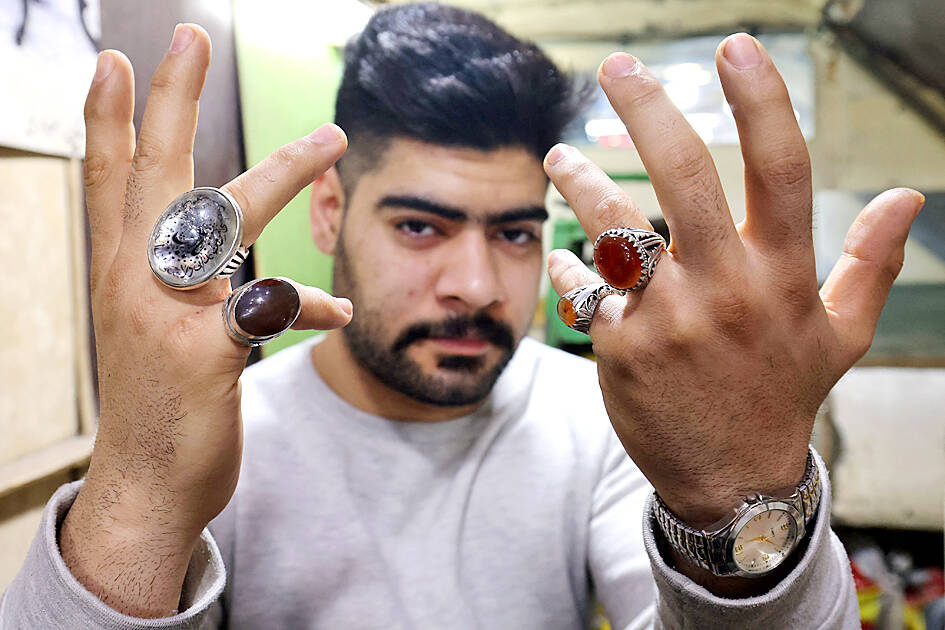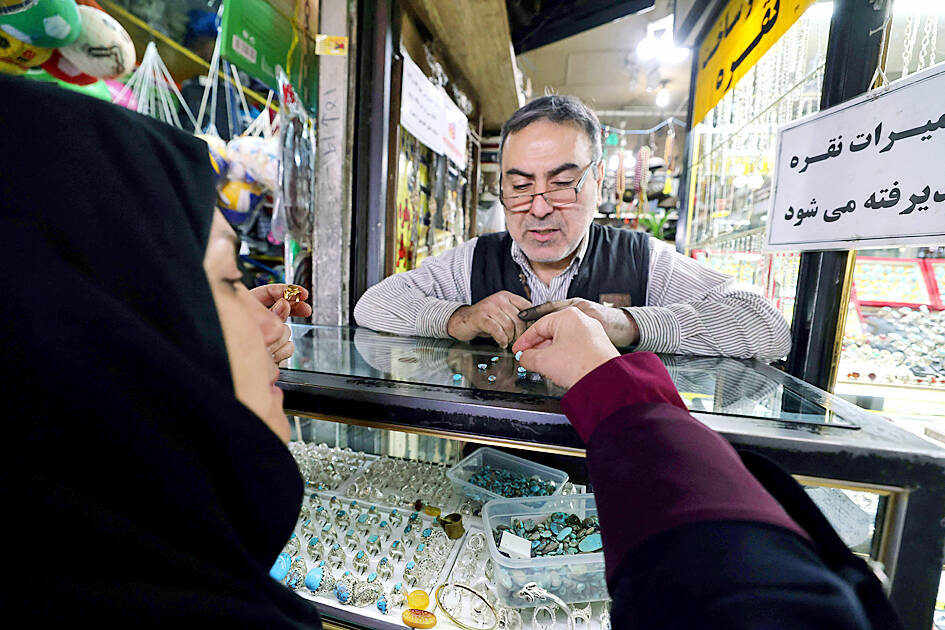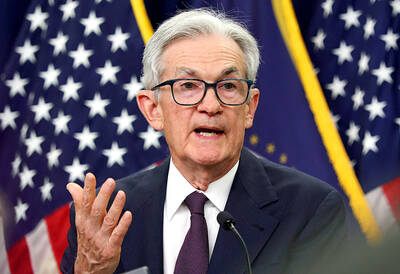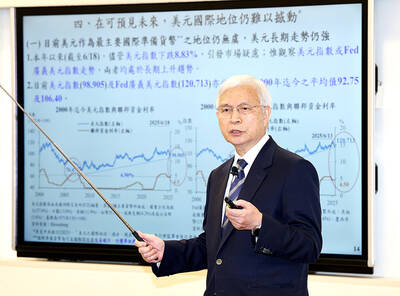At a prominent Shiite shrine in southern Tehran, Qasem Ashgari was buying yet another gemstone ring in the hope it would help his prayers to be answered promptly.
Asghari, in his 30s, who was already wearing several bands on each hand, had a specific ring in mind: a silver one, adorned with yellow agate and engraved with religious scripts.
“The reward of one prayer is multiplied ... if done with an agate ring,” he said, while strolling through the meandering alleys of the market near Shah Abdol-Azim Shrine.

Photo: AFP
Asghari’s appreciation for gemstones is shared by many Shiite Muslims in Iran, where prominent male academics and senior officials often publicly sport similar rings.
Many in the Shiite-majority country attribute high religious significance to gemstones, which they view as a way to ensure divine protection, ward off evil and prevent poverty.
Common beliefs associated with gemstones are largely what motivates people to buy them, said Hassan Samimi, a lapidary at the market.

Photo: AFP
“It is very rare to find someone who wears a ring just for its beauty,” Samimi, 52, said, in his workshop where he carves large uncut gemstones for rings, necklaces, prayer beads and other items.
Inside, one customer, Maryam, browsed through a collection of rings bearing agate, turquoise, topaz, lapis lazuli, emeralds and other stones.
“I get a good feeling from these stones,” the 50-year-old teacher said, after picking a turquoise set comprising a ring, earrings and a bracelet.
Samimi said his sales were mostly from agate and turquoise, the most revered stones, especially among Iran’s religious community.
Turquoise has been mined in the country since the times of ancient Persia, with Iran home to one of the oldest such mines in the world.
Its bluish-green color has inspired artists over the years and features prominently in Persian monuments and artifacts as well as Islamic architecture.
The turquoise from the eastern city of Neyshabur “is the most expensive,” Samimi said. “The smoother and bluer the turquoise is, the higher its price is.”
Hamid Rashidi, another craftsman, said the stone is generally affordable, but depending on the quality a piece could sell for as much as 4 billion rials (US$95,125).
Many Iranians believe it attracts wealth to the bearer and sometimes cite the religious saying “the hand that wears turquoise... will never see poverty.”
It is also believed “to enhance eyesight and calm the nerves,” Samimi said.
Agate, especially from Yemen, is also popular “because it is recommended by imams” who often claim it can boost livelihoods, Rashidi said.
Senior officials including Iranian Supreme Leader Ayatollah Ali Khamenei have often been spotted wearing rings with agate or turquoise stones, and he has been known to gift them as tokens of his appreciation.
The body of the revered Iranian Revolutionary Guards Corps commander general Qasem Soleimani, who was killed in a 2020 US strike in Baghdad, was in part identified by the agate ring he wore.
Iran subsequently declared the ring “cultural heritage” and a “national asset.”
Demand for gemstones has remained relatively steady despite Iran’s severe economic challenges, Samimi said.
Inflation in the country has in the past few years hovered near 50 percent, while the rial has sharply declined against the dollar.
“The stones market has become much better” over the years, he said, adding that there had been a significant increase in the number of craftsmen in the market compared with nearly three decades ago.
Its continued success might hang on evolving tastes.
Samimi said that agate and turquoise are not popular among younger generations.
“Young people mostly buy rubies and emeralds and birthstones,” he said. “For them, they are more fashionable.”

DIVIDED VIEWS: Although the Fed agreed on holding rates steady, some officials see no rate cuts for this year, while 10 policymakers foresee two or more cuts There are a lot of unknowns about the outlook for the economy and interest rates, but US Federal Reserve Chair Jerome Powell signaled at least one thing seems certain: Higher prices are coming. Fed policymakers voted unanimously to hold interest rates steady at a range of 4.25 percent to 4.50 percent for a fourth straight meeting on Wednesday, as they await clarity on whether tariffs would leave a one-time or more lasting mark on inflation. Powell said it is still unclear how much of the bill would fall on the shoulders of consumers, but he expects to learn more about tariffs

NOT JUSTIFIED: The bank’s governor said there would only be a rate cut if inflation falls below 1.5% and economic conditions deteriorate, which have not been detected The central bank yesterday kept its key interest rates unchanged for a fifth consecutive quarter, aligning with market expectations, while slightly lowering its inflation outlook amid signs of cooling price pressures. The move came after the US Federal Reserve held rates steady overnight, despite pressure from US President Donald Trump to cut borrowing costs. Central bank board members unanimously voted to maintain the discount rate at 2 percent, the secured loan rate at 2.375 percent and the overnight lending rate at 4.25 percent. “We consider the policy decision appropriate, although it suggests tightening leaning after factoring in slackening inflation and stable GDP growth,”

Meta Platforms Inc offered US$100 million bonuses to OpenAI employees in an unsuccessful bid to poach the ChatGPT maker’s talent and strengthen its own generative artificial intelligence (AI) teams, OpenAI CEO Sam Altman has said. Facebook’s parent company — a competitor of OpenAI — also offered “giant” annual salaries exceeding US$100 million to OpenAI staffers, Altman said in an interview on the Uncapped with Jack Altman podcast released on Tuesday. “It is crazy,” Sam Altman told his brother Jack in the interview. “I’m really happy that at least so far none of our best people have decided to take them

As they zigzagged from one machine to another in the searing African sun, the workers were covered in black soot. However, the charcoal they were making is known as “green,” and backers hope it can save impoverished Chad from rampant deforestation. Chad, a vast, landlocked country of 19 million people perched at the crossroads of north and central Africa, is steadily turning to desert. It has lost more than 90 percent of its forest cover since the 1970s, hit by climate change and overexploitation of trees for household uses such as cooking, officials say. “Green charcoal” aims to protect what